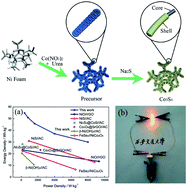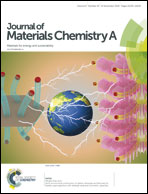Superior cycling stability of a crystalline/amorphous Co3S4 core–shell heterostructure for aqueous hybrid supercapacitors†
Abstract
In this article, a novel crystalline/amorphous Co3S4 core–shell heterostructure supported on nickel foam is fabricated through a facile method. Due to the unique structure of the crystalline Co3S4 core that provides stable mechanical support and surface-active sites and the amorphous shell that facilitates diffusion and reaction of electrolyte ions, the obtained crystalline/amorphous Co3S4 electrode shows a superior pseudocapacitive performance of 2.65 F cm−2 (2038.5 F g−1) at a current density of 5 mA cm−2 and even 1.81 F cm−2 (1392.3 F g−1) at 50 mA cm−2. In addition, the Co3S4//AC exhibits a relatively high energy density of 54.78 W h kg−1 at a power density of 400.02 W kg−1 and excellent cycling performance (about 94.8% capacitance retention over 32 500 cycles). The kinetic analysis reveals a diffusion controlled faradaic characteristic of Co3S4 (73.21% diffusion-controlled contribution). Moreover, the fabrication process presented in this work is facile, cost-effective, and environmentally benign, offering a feasible solution for fabricating next-generation high-performance energy storage devices.



 Please wait while we load your content...
Please wait while we load your content...